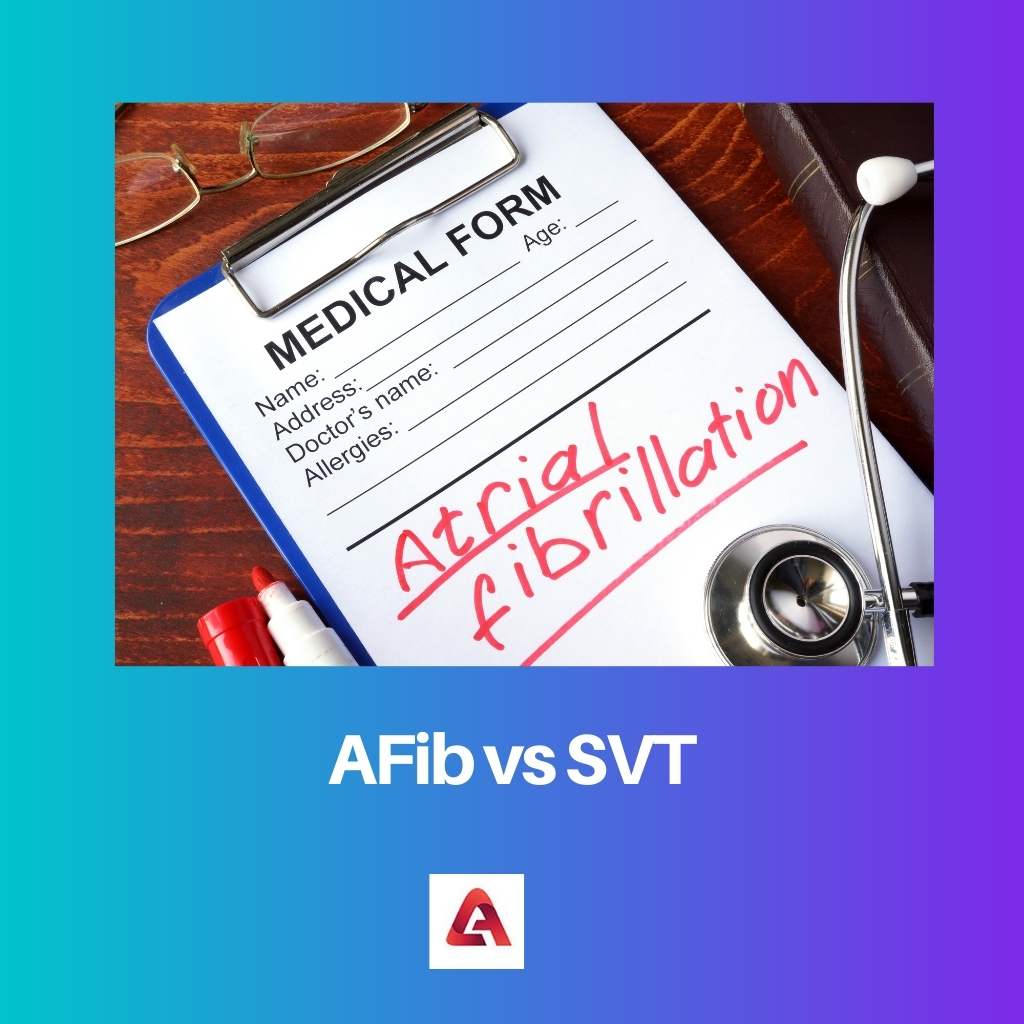There are two main types of arrhythmia or irregular heart rhythms. These are atrial fibrillation (AFib) and supraventricular tachycardia (SVT).
Key Takeaways
- AFib is an irregular heartbeat caused by a malfunction in the heart’s electrical system, while SVT is a rapid heartbeat caused by abnormal electrical impulses in the heart.
- AFib can increase the risk of stroke and heart failure, while SVT is not life-threatening.
- AFib is treated with medication, cardioversion, or ablation, while SVT is treated with medication or ablation.
AFib vs SVT
AFib is a type of cardiac arrhythmia characterized by a rapid and irregular heartbeat, where the heart’s upper chambers quiver instead of beating normally. SVT is a type of cardiac arrhythmia that causes a very rapid heartbeat originating from the atria or the atrioventricular node.

Atrial fibrillation, also known as ‘AFib,’ is one of those types of heart rhythms. With this condition, the upper chambers are sending electrical signals to them at an extremely high rate.
It’s called supraventricular tachycardia because the heart beats so quickly that there are extra waves of electrical activity above and below the ventricles (the lower chambers), which receive blood from your body before sending it to your lungs.
Comparison Table
| Parameters of Comparison | AFib | SVT |
|---|---|---|
| Full form | Atrial fibrillation | Supraventricular tachycardia |
| Treatment | Medication, but ablation if the patient does not follow up with their doctor’s recommendations and continues to have problems. | Ablation is only necessary if the patient does not respond to medication or other treatment options. |
| EKG (Electrocardiogram) | Irregularly shaped (irregular) rhythm in the EKG, with a fast heart rate. | Regular but faster than normal heartbeat when not treated. |
| Risk Factors | Older age, family history of heart disease or stroke, high blood pressure or diabetes. | Rare cases can be associated with structural defects like holes between the upper chambers (atrial septal defect/ASD). |
| Symptoms | It may or may not present with symptoms. | Palpitations that are rapid, forceful and irregular; dizziness; fatigue. |
What is AFib?
AFib, on the other hand, is when both the atria and ventricles beat outside of their normal rhythm. This causes blood to pool in the heart’s chambers and can lead to a stroke or congestive heart failure if it persists untreated for too long.
It can be difficult for doctors to detect and monitor irregular heartbeats because they may not always notice symptoms such as fatigue or shortness of breath that occur with abnormal heartbeats.
This condition can lead to blood clots and strokes if left untreated, but it is treated with medication that manages symptoms over time.
Some patients who suffer from AFib also have chronic kidney disease or coronary disease, and these conditions increase the risk of stroke.

What is SVT?
SVT, or supraventricular tachycardia, is a type of rapid heartbeat that originates in the upper chambers of the heart.
This condition starts with an ectopic beat – one that comes from somewhere other than one of your natural pacemaker sites within either ventricle.
It occurs in people between the ages of 40 and 60, although it can also happen to younger adults or children as well.
SVT is caused by abnormal electrical signals that cause a rapid heartbeat because one chamber becomes too excited when contracting while another does not work properly at all.
SVT is a dangerous heart condition that needs immediate attention from medical professionals. It can lead to other health issues, such as blood clots or strokes, if medications do not work properly over time.
Main Differences Between AFib and SVT
- AFib may lead to other health issues, such as blood clots or strokes if medications do not work properly over time, while SVT can be treated with medicine.
- AFib may occur if the electrical signals in your heart are out of sync, while SVT occurs due to a problem with your nervous system.
- https://www.ahajournals.org/doi/abs/10.1161/circoutcomes.114.001263
- https://www.sciencedirect.com/science/article/pii/S0741521498702332